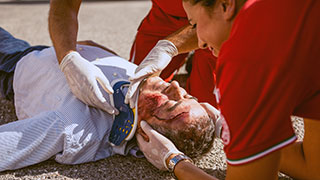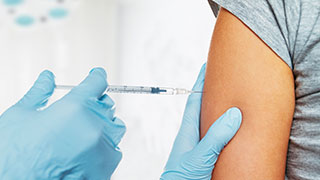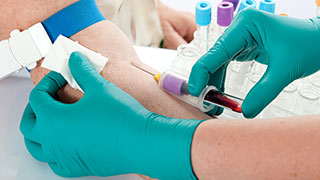Bloodborne pathogens are germs that are present in the blood and can cause diseases. These germs may include:
Anyone exposed to blood, saliva, or other body fluids visibly contaminated with blood are at risk. Some people are at higher risk of being exposed, such as first responders and health care workers. People can be exposed to bloodborne pathogens through many different ways, such as:
- When blood or body fluid from one person enters the body of another person (e.g., someone’s blood splashes into someone else’s mouth, a human bite that breaks the skin); or
- When an object contaminated with blood or body fluid enters into another person’s body (e.g., getting stuck by a used needle).

Some ways to reduce your risk include:
- Practice good hand hygiene. Wash your hands with soap and water for at least 15 seconds.
- Your skin is a barrier against germs. Protect your skin by keeping it well moisturized. Cover up cuts or wounds.
- Wear the proper personal protection equipment, such as gloves, if there is a chance that you may be exposed to blood or body fluids. Clean and disinfect all equipment and work surfaces soiled by blood or body fluids. Follow your workplace policies and procedures.
- Dispose of sharps properly and carefully in sharps containers. Follow your workplace policies and procedures.
- Do not share personal objects, such as razors, water bottles, needles, or other drug-related equipment.
- Get vaccinated. Make sure you are up-to-date with your hepatitis B vaccinations.
- Practice safer sex and use condoms and/or dental dams.
- Prior to travelling, visit a travel health clinic or your primary health care provider to assess your risk and get education about how to prevent exposure.
- Ask your doctor or nurse practitioner to assess your current risk for exposure and see if you require screening tests for bloodborne infections.

According to the Ontario Hospital Association and Ontario Medical Association’s Blood-borne Diseases Surveillance Protocol for Ontario Hospitals, after a needle-stick injury from a needle contaminated with hepatitis B in the health care setting, the chance of being infected is 6 to 30%. In similar situations, there are lower risks of being infected for HIV (0.3%) and hepatitis C (1.8%).
Your risk of acquiring infections can vary, depending on several factors, including the type of injury, the infection status of the individual whose blood you were exposed to, the amount of virus in the blood or body fluid, and your own health status. That is why it is important to seek immediate medical attention from a health care provider who can assess your risk and decide whether or not you need to start treatment or preventive measures.
- Let any wound bleed freely, and then thoroughly wash the exposed area with soap and water. If you were splashed by blood or body fluids in or around the eyes, nose, or mouth, flush the area with water.
- Report to your supervisor or manager, if applicable. You may need to fill out an incident report.
- Check to see if the Mandatory Blood Testing Act applies to you. If it does, ensure you apply within 30 days of exposure.
- Seek immediate medical attention from your local emergency department as some treatment must be started within a time frame in order for it to be beneficial. It is recommended that you go to the emergency department because, at the moment, it is where all treatment is available if needed.
- In addition to caring for your wound, the emergency department staff will take your blood to be tested for HIV, hepatitis B, and hepatitis C as a baseline. If you are infected, it may take time for it to show in the blood. Baseline blood work tells you if you have had these infections before the injury and determines if you are already protected from Hepatitis B. It also helps you with any future claims for compensation if this exposure was related to your work. Not doing this baseline blood work may jeopardize any future claims. Your family doctor may obtain these results by calling the main Public Health Laboratory or request it from the hospital’s records management department.
- The emergency department staff will assess whether you need treatment or preventative measures.
- If you are eligible for the Mandatory Blood Testing Act, make sure to inform the health care provider that you would like to apply for the Act and ask that they complete the necessary forms (see below).
- If the exposure occurred while you were working, the health care provider will also help you fill Workplace Safety and Insurance Board (WSIB) forms.

- Follow-up treatment depends on your risk assessment and test results. You may need to continue the treatment or vaccination series, if it is recommended by emergency department staff.
- You will need to do follow-up blood tests at recommended times, usually with your family doctor or nurse practitioner. This is important because some infections take longer to show up in the blood test, and you may not know that you are infected because you may not show any symptoms. For example, hepatitis B infection may take 6 months to show up in a blood test. Completing the follow-up blood tests ensures that you receive medical treatment as soon as possible. Table 1 outlines the recommended tests and their timing.
- If you observe symptoms of concern such as nausea, abdominal pain, or jaundice (yellowing of the whites of the eyes and skin) during this time, seek immediate medical attention.
| Time after Exposure | Blood Tests |
|---|---|
| Baseline (when first exposed) | HIV, Hepatitis B (HBsAg, anti-HBs, and anti-HBc), Hepatitis C, and liver function tests |
| 6 weeks | HIV, Hepatitis B (if required), and Hepatitis C |
| 3 months | HIV, Hepatitis B (if required), Hepatitis C, and liver function tests |
| 6 months | HIV, Hepatitis B (if required, Hepatitis C, and liver function tests |
| 1 year | HIV (if source has both Hepatitis C and HIV or if post-exposure prophylaxis (PEP) is being used) |

